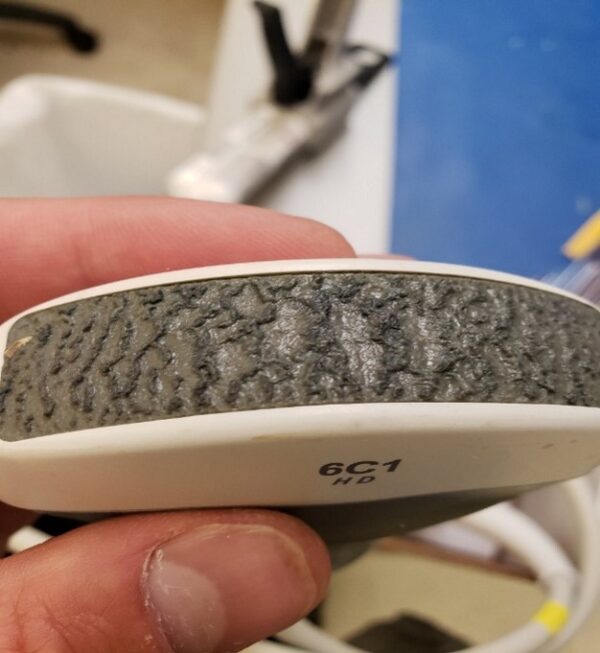High-Level Disinfection – Ultrasound Probes
The Corner Office
Wayne Moore
10/10/2023

From the American Institute of Ultrasound in Medicine (AIUM)
“Without proper care of US probes and equipment, US imaging performance can be reduced. In a study it was seen that the performance of probes in routine clinical practice was compromised in some manner in 39.8% of the evaluated transducers. Another study examining the failure rate of ultrasound systems in a hospital setting showed that of the total failures, 12% of them were due to the ultrasound system and 88% were due to the transducer. It was also reported that common performance compromising transducer failures are lens delamination or some form of element damage in the transducer array. Damaged transducers due to dead elements or elements with reduced sensitivity may reduce resolution and penetration, increase the noise floor, cause Doppler velocity errors, produce flow direction ambiguity, and increased spectral broadening.”1
Acertara has long been at the forefront of recognizing the vital role fully functional ultrasound probes play in the acquisition of anticipated diagnostic ultrasound studies as detailed in our seminal paper on the subject published in 2003 in the Journal of Diagnostic Sonography, “The Methods and Effects of Transducer Degradation on Image Quality and the Clinical Efficacy of Diagnostic Sonography”. Through our experience in this field, we developed the first commercially available probe testing device known as FirstCall, an electrical leakage tester known as AmpSafe, and a contemporary tissue mimicking phantom known as Advantage. These tools were developed to help HTMs, and Sonographers identify problems in probe performance early in the failure process – before patient images were compromised and while probes could still be economically repaired.
 We also learned during the COVID-19 pandemic that ultrasound probes were often brutalized during high level disinfection due to use of non-OEM tested chemicals or non-traditional cleaning methods. The probe picture shown to the right is an example of what happened to a lens when the wrong disinfectant was used. To address this issue our R&D team began developing a breakthrough automated HLD probe device that combined probe disinfecting and electrical leakage testing coupled with cloud-based communications that automatically alerts the cleaning personnel as well as the HTM of a potential probe failure discovered during the HLD process. This prevents a potential patient safety and prevents an unnecessary expensive probe failure due to fluid ingress. The integration of discovery technologies was developed to address the AIUM’s concerns also expressed in their Official Statement (highlighted below); “Using chemicals and reprocessing protocols or methods not validated by the responsible OEM may potentially damage a given transducer and present a patient safety issue or produce a non-diagnostic study. Even when following the cleaning, disinfection, and sterilization guidelines provided by various clinical societies, damage to ultrasound transducers may occur. It is essential, therefore, to both strictly follow the OEM transducer reprocessing guidance and inspect the transducer prior to clinical scanning for changes in visual appearance and function to ensure the transducer appears fully functional and clinically efficacious.
We also learned during the COVID-19 pandemic that ultrasound probes were often brutalized during high level disinfection due to use of non-OEM tested chemicals or non-traditional cleaning methods. The probe picture shown to the right is an example of what happened to a lens when the wrong disinfectant was used. To address this issue our R&D team began developing a breakthrough automated HLD probe device that combined probe disinfecting and electrical leakage testing coupled with cloud-based communications that automatically alerts the cleaning personnel as well as the HTM of a potential probe failure discovered during the HLD process. This prevents a potential patient safety and prevents an unnecessary expensive probe failure due to fluid ingress. The integration of discovery technologies was developed to address the AIUM’s concerns also expressed in their Official Statement (highlighted below); “Using chemicals and reprocessing protocols or methods not validated by the responsible OEM may potentially damage a given transducer and present a patient safety issue or produce a non-diagnostic study. Even when following the cleaning, disinfection, and sterilization guidelines provided by various clinical societies, damage to ultrasound transducers may occur. It is essential, therefore, to both strictly follow the OEM transducer reprocessing guidance and inspect the transducer prior to clinical scanning for changes in visual appearance and function to ensure the transducer appears fully functional and clinically efficacious.
Multiple published papers over the years have demonstrated that “reusing transducers that have been damaged during reprocessing will potentially negatively affect the acquired images. Echo contrast or flow velocity from these distorted images may provide inaccurate measurement results and misleading diagnosis.” Adding discovery technologies to the HLD process will lead to a more efficacious and safer HLD process that will benefit both the patient and the life cycle (expense) of the ultrasound probe. That was our focus in developing our new HLD device, Accelera, which will be commercially available in 2024.
Until Next Month,

Wayne
